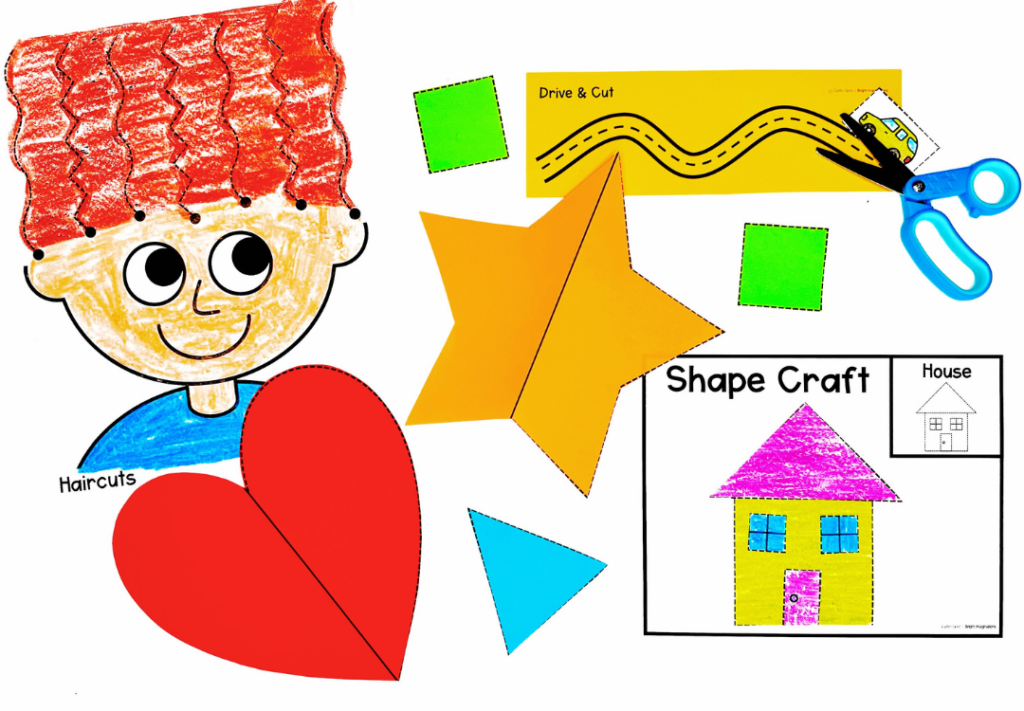Why Are Scissor Skills Such a Big Deal?
You might be surprised, but scissor skills are super important for young kids! When they learn to cut with scissors, they’re not just having fun—they’re building up those tiny hand muscles crucial for everyday tasks like writing, buttoning up their coats, or even holding a spoon. Cutting also helps with hand-eye coordination, focus, and patience. It’s a small skill with big benefits!
To dive deeper into the importance of fine motor development and how it impacts skills like cutting, check out my blog on Fine Motor Development.

What Scissor Skills Should Kids Have by Kindergarten?
By the time they’re ready for kindergarten, kids should have some basic scissor skills down. Here’s what you can expect:
- Holding Scissors the Right Way: They should know how to hold the scissors properly, with their thumb in the smaller loop and fingers in the larger one, while the other hand guides the paper.
- Cutting Along Straight Lines: They should be able to cut straight lines with control.
- Snipping Simple Shapes: Cutting out basic shapes like squares, circles, and triangles should be manageable.
- Showing Control: You’ll want to see smooth, even cuts instead of choppy ones, showing they’ve got good control and coordination.
These skills are like stepping stones that will help them tackle more complicated tasks as they grow.

Need activities to help students practice? My Scissor Skills Bundle is packed with fun, ready-to-go resources designed to help kids master these milestones.
How to Introduce Scissors Safely
Safety first! When you’re introducing scissors to little ones, it’s important to start off on the right foot:
- Start with Kid-Friendly Scissors: Grab some child-safe, blunt-tip scissors. These are designed just for little hands and are way less sharp than adult scissors.
- Teach the Proper Grip: Show them how to hold the scissors correctly, with their thumb in the top loop and fingers in the bottom loop. Then, have them practice opening and closing the scissors slowly and with control.
- Practice Makes Perfect: Before cutting anything, let them practice the motion of opening and closing the scissors. This helps them get the hang of it and strengthens their hands.
- Set Some Ground Rules: Lay down the law early—scissors are for sitting down only, fingers stay away from the blades, and absolutely no running with scissors!
- Keep a Close Eye: Make sure you’re watching closely, especially when they’re first starting out. A little guidance goes a long way in keeping things safe.
When to Squeeze Cutting Activities Into Your Day
Finding time for scissor practice can be easier than you think. Here are some perfect times to work it into your day:
- Morning Work: Start the day with some simple cutting tasks during morning work. It’s a nice way to ease kids into the school day while practicing an important skill.
- Art Time: Incorporate cutting into your art projects. Whether it’s making collages, cutting out shapes, or creating paper chains, kids will love using their scissors creatively.
- Centers or Stations: Set up a cutting station during center time. They can work on cutting lines, shapes, or even playdough—it’s all good practice!
Adding fine motor activities to your morning routine? Don’t miss my blog on How to Set Up Morning Tubs for even more ideas!

Fun and Easy Cutting Ideas
Making scissor practice fun is the key to keeping kids engaged. Here are some easy and enjoyable cutting ideas to try:
- Straight Lines and Simple Shapes: Start with straight lines, then move on to wavy lines and simple shapes like circles and squares. Turn it into a game by having them “rescue” a character or reach a finish line with their cuts.
- Paper Plate Projects: Give them a paper plate to cut up! They can make masks, suns with rays, or whatever else they can imagine. It’s a great way to practice circular cutting.
- Snipping Straws or Playdough: Let them practice cutting by snipping straws or cutting playdough into pieces. It’s a fun twist and great for building those cutting muscles.
- Create Collages: Hand out some old magazines or colorful paper scraps for them to cut out and glue into collages. It’s creative and great for scissor control.
- Seasonal Crafts: Work on some seasonal crafts that involve cutting, like making paper snowflakes in winter or cutting out flowers in spring. It’s festive and perfect for fine-tuning their skills. Interested in cutting crafts for every season? Check out my full collection of one-page crafts!
Let’s “Cut” to the Chase…
Mastering scissor skills is a big milestone for young learners. With safe introductions, engaging activities, and the right tools, your students will build the fine motor skills they need to thrive in and out of the classroom.
Want more tips and resources? Visit my blog on Fine Motor Development or check out my Scissor Skills Bundle to get started today!
